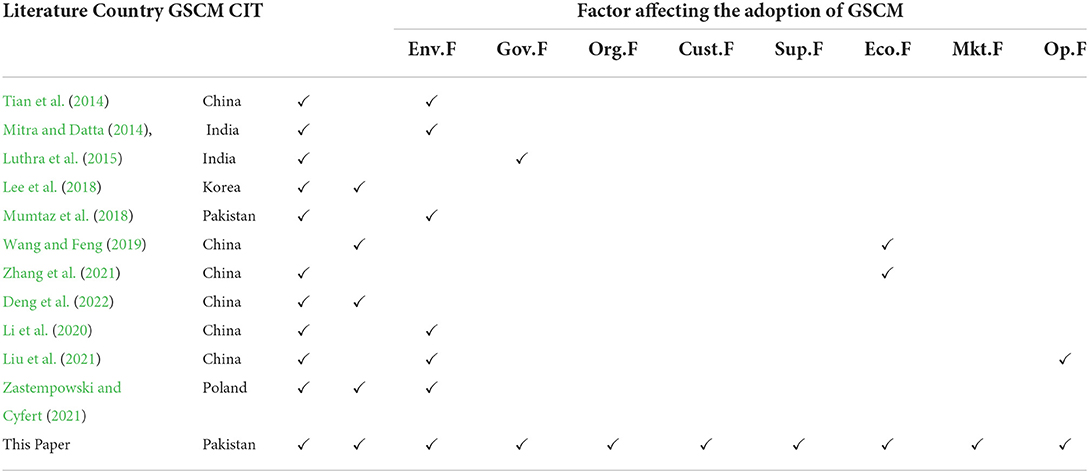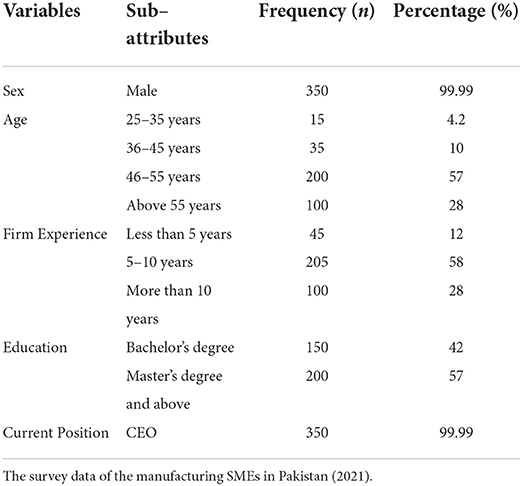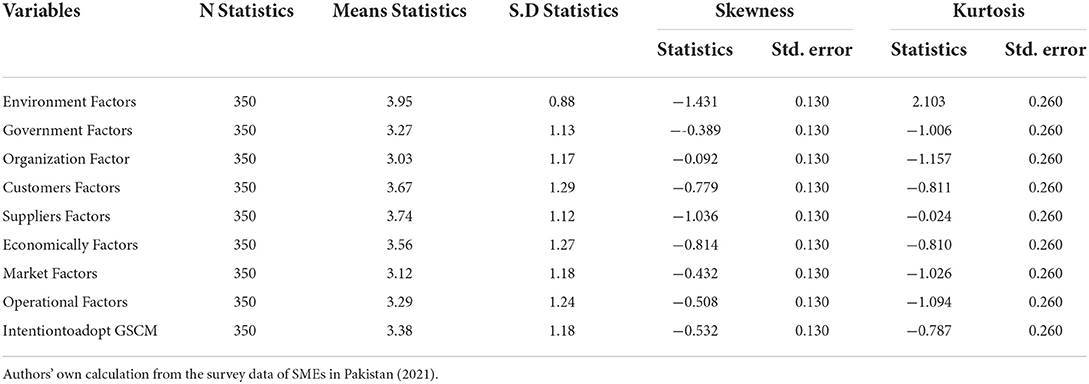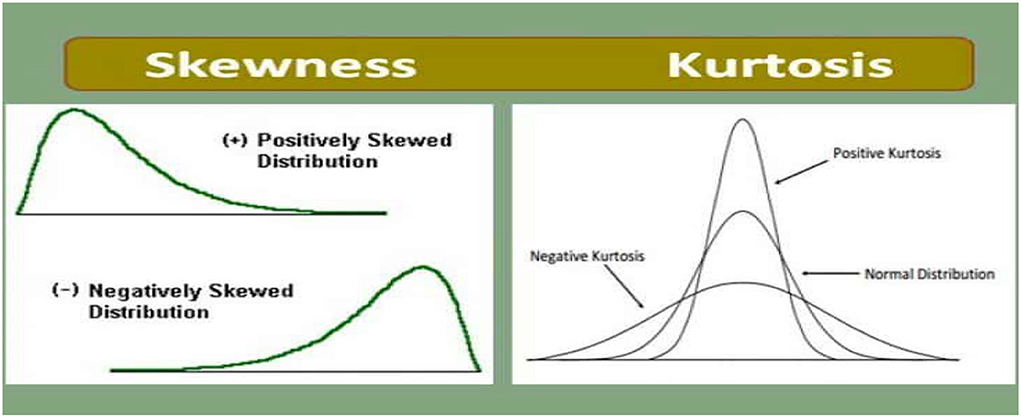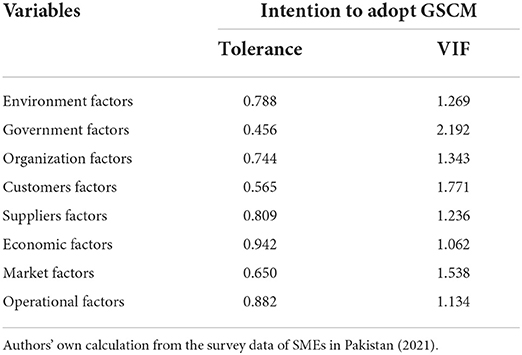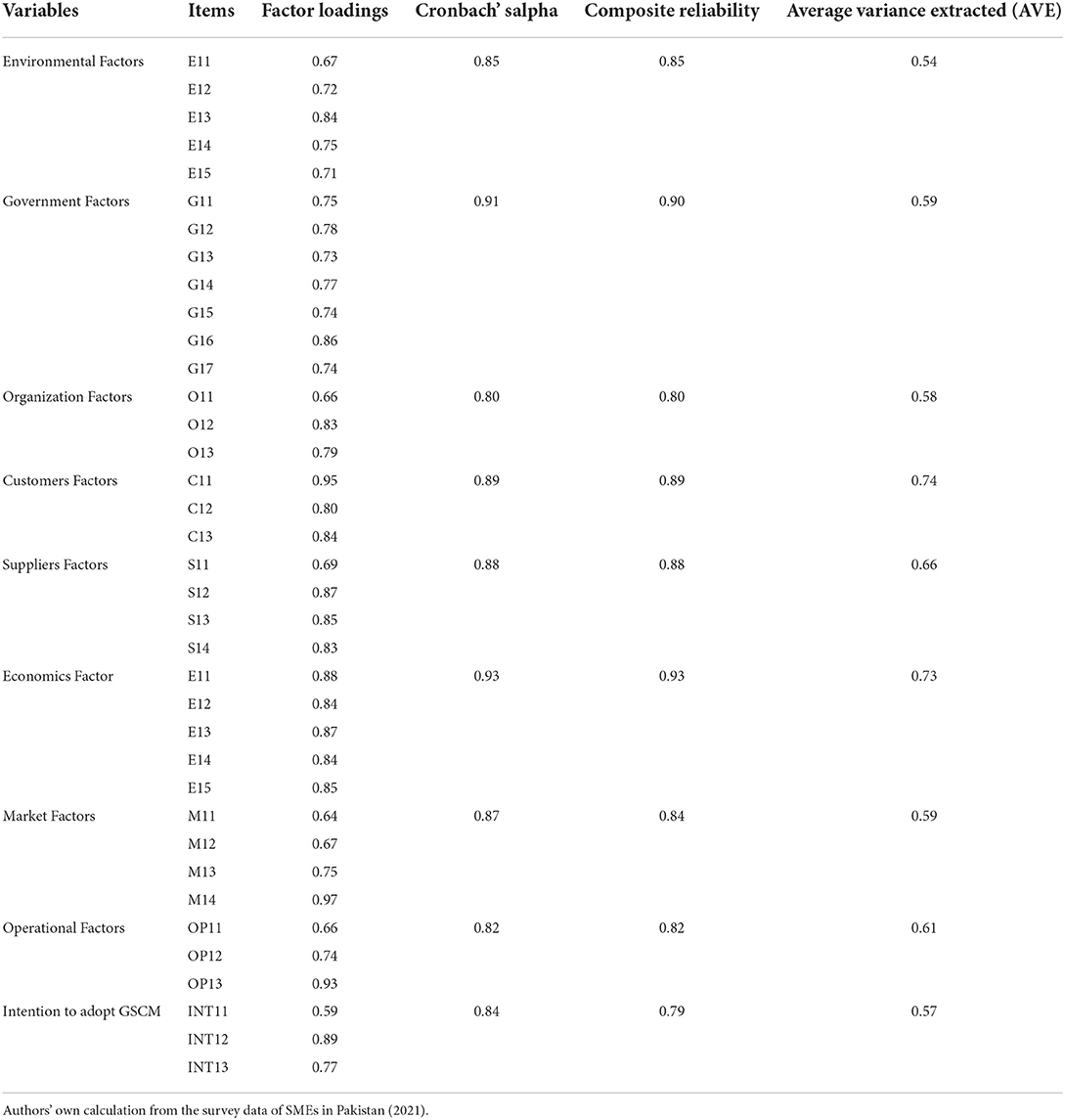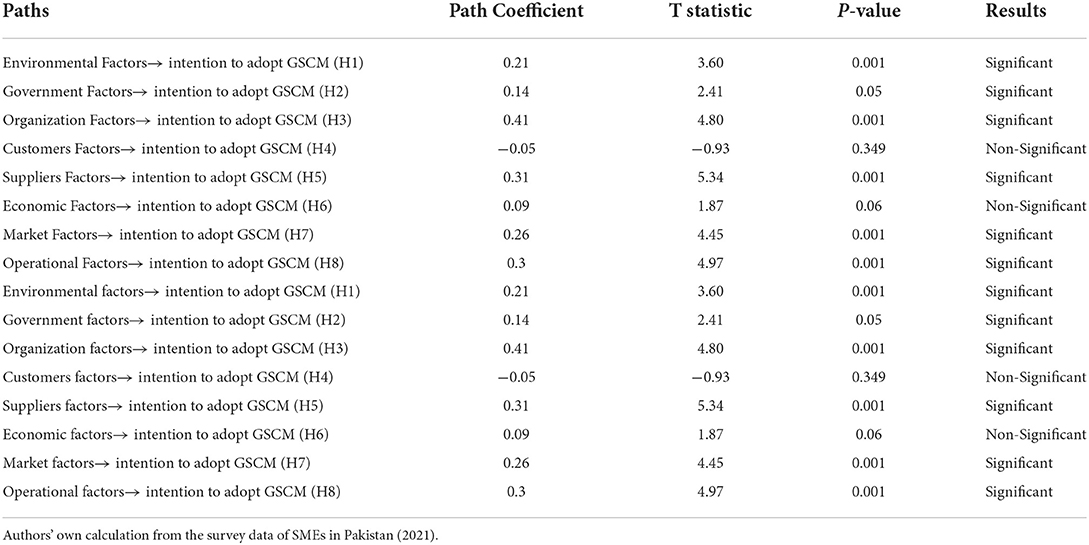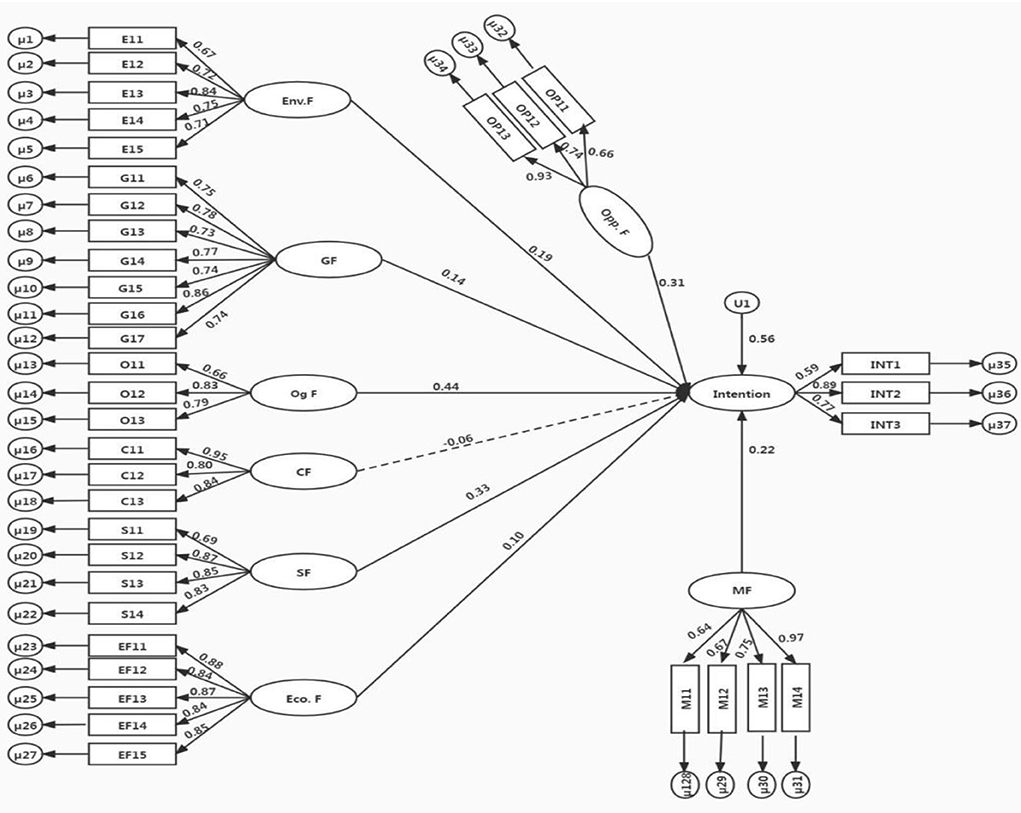- 1School of Business, Qingdao University, Qingdao, China
- 2School of Economics and Finance, Xi'an Jiaotong University, Xi'an, China
Organizational sustainability in the form of environmental management and sustainable production is becoming more important for small and medium-sized enterprises (SMEs) throughout the world. This research evaluates the factors affecting the understanding of the CEO's and managers' intention to adopt practices of green supply chain management (GSCM) and clean innovation technology (CIT) in the manufacturing SMEs of Pakistan. This empirical research identifies key determinants influencing the adoption of GSCM practices. Using structural equation modeling (SEM), we selected a sample size of 350 different manufacturing firms in Pakistan. The results of the study revealed that six factors, namely, environmental, government, organization, suppliers, market, and operational factors, significantly influence the intention to adopt GSCM and positively impact sustainable production. The study's findings reveal that market and operational factors are highly significant for adopting GSCM practices at a p-value of 0.05. Environmental and organizational factors are equally significant to adopt GSCM practices at a p-value of 0.10. This research also analyzed CIT as a moderator between environmental, government, organization, customer, supplier, economic, market, and operational factors in the context of Pakistan. Hypotheses H9a, H9b, H9f, and H9g were validated and support the use of CIT to boost enterprise production and consumption. The research findings would help policymakers understand how to implement GSCM practices and guide enterprises to implement GSCM and CIT practices for enhancing enterprise performance and environmental sustainability.
Introduction
Green supply chain management (GSCM) practices are important for firms because they help in increasing profitability by reducing environmental and health risks, which are major customer concerns, and make a firm more sustainable and resilient (Shekarian et al., 2022). The firm can reduce the long-term cost and risk of its supply chain which can help to minimize its impact on the environment and public health. In addition, through the adoption of GSCM, organizations can shape the future of how businesses will be managed, reducing costs, and boosting sustainable products (Darwish et al., 2021). Green supply chain management is a relatively new concept. But in the present scenario, the health of the environment and its sustainability is a major concern for all enterprises. Businesses face two major challenges that are responsible for the lack of people's interest in GCSM. First, is the standardization of the practices, and second, is the lack of a self-regulatory environment (Rupa and Saif, 2022).
Worldwide, economic growth, sustainable production, environmental degradation, as well as high-quality output have been a priority for many countries (Liu et al., 2018). Business enterprises of all sizes try to produce environment-friendly products using environment-friendly methods. The enterprise's performance in environmental management and sustainable production and consumption is essential for small and medium-sized enterprises (SMEs) (Younis and Sundarakani, 2020; Lu et al., 2022; Selviaridis and Spring, 2022). Currently, increasing production and consumption have led to a deterioration of the environment and a variety of health problems, pollution, water waste, and excess carbon emissions. In this context, CEOs and other top managers are being driven to reevaluate their supply chain strategy for sustainable production and consumption.
The adoption of GSCM practices can benefit from the latest scientific and technological achievements in sustainable production and consumption in the organization. In this context, organizations should ask the following questions to influence the intention of CEOs and senior managers to adopt the GSCM practices: Has the adoption of GSCM practices had an impact on sustainable production and consumption? If so, what are the factors? What is the impact of adopting innovative technologies on income and business profit? This research aims to provide scientific answers to these questions to not only clarify scientifically how the adoption of GSCM practices increases organizations' production but also suggest policy measures that will help adopt GSCM practices in SMEs in Pakistan. Due to rapidly increasing globalization, GSCM and clean innovation technology (CIT) have greater importance and are environmentally friendly for manufacturing SMEs (Tachizawa and Wong, 2015; Nayak, 2020; Zhang et al., 2021). The adoption of GSCM and CIT practices has a substantial impact on the development of enterprises with benefits as well as lower energy costs. It also plays a key role in the development of sustainable production, green innovation, environmental sustainability, and the improvement of relationships between suppliers and customers (El Baz and Iddik, 2022; Liu et al., 2022). The adoption of GSCM and CIT encourages sustainable production and consumption for manufacturing SMEs. Despite the increasing popularity of GSCM and CIT in many countries, some issues still need to be addressed. In addition, most studies have focused on large enterprises adopting the GSCM, but in our study, manufacturing SMEs were explored for adopting GSCM and CIT.
The adoption of GSCM and CIT has great importance for profit-generating activities, business developments, environmental impact, and the production of enterprises (Zhang and Zhao, 2022). In many enterprises, the practices of supply chain management and environmental management are intertwined via GSCM as long-term operations will increase the competitiveness of the enterprises. Since the use of the GSCM and CIT provides more advantages and influences friendly relationships with both suppliers and consumers internally and externally, the implementation of GSCM and CIT has a significant impact on enterprises' performances and product development. Green supply chain management contributes to corporate CIT and sustainable production and increases the enterprise's efficiency (Li et al., 2020). The adoption of GSCM and CIT boosts enterprise development, reduces environmental issues, and increases the level of production and consumption. Multiple studies have indicated a positive relationship between GSCM and CIT implementation (Zaid et al., 2018). In the manufacturing industry, many factors like awareness of consumers, quality of resource management, stakeholder pressure, and government support influence the adoption of GSCM and CIT for sustainable production and consumption (Jum'a et al., 2021; Banik et al., 2022).
The adoption of GSCM and CIT has been studied in many countries, but there is still a gap in the literature about its adoption in developing countries like Pakistan. In Pakistan, it is generally ignored, especially its impact, and research on the relationship between GSCM and CIT is scarce. The existing literature focuses on specific dimensions such as supplier cooperation, green consumption, and environmental management in organizations. To the best of our knowledge, the adoption of GSCM and CIT for manufacturing SMEs in Pakistani is a new research topic, and this is the first study of its kind to examine the factors influencing the decisions on GCSM. The main purpose of this study is to identify critical success factors for manufacturing SMEs in Pakistan to adopt GSCM and CIT. The results of this study will fill the gap to identify critical success factors that affect the intention of CEOs to adopt GSCM and CIT in their companies. Finally, this study also helps decision-makers to understand the adoption of the GSCM and support SMEs to implement CIT.
Literature review
Green supply chain management
The adoption of GSCM is significant in many sectors of the enterprise including human resources, management support, environmental friendliness, business enhancement, sustainable production, customer satisfaction, perceived relative advantage, and cost reduction (Luthra et al., 2015; Zaid et al., 2018; Zhang and Zhao, 2022). It is beneficial for sustainable production by encouraging the market to become more environment-friendly, attracting new workers to the company, and helping the enterprise to establish new business opportunities in both developed and developing countries (Li et al., 2020). Pourjavad and Shahin (2020) investigated the risk of green supply chain management in the pipe industry of Iran for the fuzzy environment. They concluded that the green supply chain was very important for the improvement of the environment within the company. Their findings indicated that GSCM was beneficial for saving resources, increasing environmental and operational capabilities, and helping to reduce costs and environmental degradation. Banik et al. (2022) identified critical success factors for the implementation of GSCM in the electronics industry. The results of the study demonstrated that the adoption of GSCM had a significant impact on sustainable production and consumption, enterprise efficiency, and environmental improvement in developed and developing countries.
Al Khattab and As'ad (2015) deliberated on the relationship between GSCM and environment-based firm performance. Their findings revealed that GSCM had a significant impact on the environment-based firm performance and increased the overall production and consumption of the firm. Yavari and Ajalli (2021) explored the green-resilient supply chain network under the risk of disruptions. According to the study by Sharma et al. (2017), firms were embracing GSCM practices to improve their brand image and increase their market share, and production. Their findings indicated that GSCM practices increased the production of the firms and improved their business.
Many industries adopt GSCM practices to enhance production and improve environmental performance. Similarly, Al-Ghwayeen and Abdallah (2018) explained the adoption of GSCM practices across manufacturers. Kalyar et al. (2020) identified three trends among industrial businesses opting for GCSM: early adopters, followers, and laggards. According to their study, early adopters gained substantial and favorable benefits in environmental, operational, and economic performance. Mondal and Giri (2022) explored the green closed-loop supply under the government subsidy for substitutable products and found that the government subsidy was beneficial for the development of the company.
The adoption of GSCM practices, therefore, is beneficial for sustainable production and encourages the market to become more environment-friendly, attracts new workers to the company, and helps the organization establish new business opportunities in developed and developing countries. A review of the literature shows that the adoption of GSCM and CIT had a significant impact on many aspects of the organization such as human resources, management support, environmental friendliness, business enhancement, sustainable production, customer satisfaction, perceived relative advantage, and cost reduction. Hence, the adoption of GSCM practices and CIT has become a significant topic and of interest to academics in the context of SMEs in Pakistan, along with sustainable production, consumption, and environmental improvement.
Research gap and highlights
Table 1 provides a comparative overview of the contributions of this paper and previous research. This is for the first time that a analyzes eight factors that affect the adoption of the GSCM practices utilizing CIT as a mediator in the context of manufacturing SMEs in Pakistan. Currently, no study in Pakistan has utilized CIT as a mediator. In addition, research exploring the relationship between the adoption of GSCM and CIT is scarce in Pakistan. The existing literature focuses on specific dimensions such as supplier cooperation, green consumption, environmental management in organizations, and other factors. The adoption of GSCM and CIT in manufacturing SMEs in Pakistan is a new research topic to the best of our knowledge and this is the first study of its kind to examine the factors affecting this decision. The results of this study will fill the research gap and identify critical success factors that can influence the decisions of CEOs to adopt GSCM and CIT in their companies. It will also help decision-makers understand the benefits of adopting GSCM and support SMEs to implement CIT.
Factors affecting the intention to adopt GSCM and hypotheses developments
Environmental factor
Environmental factors play an important role in the production, consumption, and development of enterprises that are committed to sustainability. Enterprises are more aware of implementing environment-friendly practices and processes to reduce their effect on the environment and increase sustainable production (Khan et al., 2019). The term “environment” refers to an enterprise's overall responsibility for its long-term viability. Environment-friendly efforts across an enterprise's GSCM may help the enterprise to enhance its environmental performance and green innovation (Kalyar et al., 2020; Wang et al., 2021). The adoption of GSCM practices minimizes environmental impact, increases production, and helps balance environmental and economic sustainability (Tian et al., 2014). Sustainable production and consumption, as well as waste management, are all considered to be key drivers for enterprises seeking to enhance their environmental performance and efficiency within the context of the GSCM framework (Laari et al., 2017). The adoption of the environmental factor must be included in strategic planning from top to bottom to achieve success and sustainable production. The long-term survival of the enterprise depends on the support of the top management in adopting and implementing new innovative technologies, programs, and activities. Environmental excellence begins with the design of products and processes. The CEO's and management's commitment to an environmentally sustainable strategy is necessary to ensure that GSCM is adopted. The environmental performance advocated in this research includes efforts such as increasing the enterprises' profit, minimizing waste, pollution, and greenhouse gas emissions and adopting GSCM for sustainable production and consumption. This study uses the same indicators of environmental performance as other studies, including environmental factors that support the enterprise's productivity and intention to adopt GSCM, which ultimately improves environmental performance. Therefore, the following hypothesis is proposed:
H1: Environmental factors directly and positively affect the intention to adopt GSCM.
Governmental factor
Across the world, governments have implemented a range of policies and initiatives to improve enterprises' performance, living standards, and economic development (Tachizawa and Wong, 2015). The government not only subsidizes enterprises' purchases of renewable energy equipment but also provides sustainable energy for the development of enterprises. Kuo et al. (2016) examined the impacts of various carbon tax policies on enterprises' investments in new innovative technology. Meng et al. (2021) found that government subsidies could reduce green products' prices and benefit the manufacturer. Sun and Li (2021) established that governments' participation could accelerate the green behavior of logistics enterprises. The conclusions from these studies demonstrate that government subsidies and new environment-friendly policies are important factors in promoting enterprises' performance and their adopting GSCM practices. The following hypothesis is proposed because of the foregoing assumptions:
H2: Governmental factors directly and positively affect enterprises' intention to adopt GSCM.
Organizational factor
An organization's internal factors determine the features that are used to evaluate and compare the performance of the enterprise. Human resource management, technology, organizational goals, and vision statements are all examples of internal company factors (Zhang et al., 2020). Production capacity, marketing strategy, management, the age of the enterprise, the expertise of the owner/manager, and organizational culture, all have a major influence on the internal organization of a company (Al-Swidi et al., 2021). The strength among employees is a critical internal business component since it is directly tied to the success of an organization. Employees who are devoted, passionate, and welltrained make a significant contribution to the success of the enterprise. The internal factors of the organization contribute to adopting GSCM. Taking cognizance of the influence of an organization's internal dynamics, the following hypothesis is proposed:
H3: Organization factors directly and positively affect the intention to adopt GSCM.
Customer factor
The customer is also an important factor in the enterprise's development and performance (Feng et al., 2018). Customer satisfaction has emerged as a critical component in business strategy because higher levels of customer satisfaction are associated with increased customer loyalty, which may result in increased profits for the enterprise (Bowen and Chen, 2001). Lv and Li (2021) studied the influence of green consumers on enterprises' green innovation. Customers, therefore, play an essential part in GSCM. Previous research has established that customer cooperation has a positive impact on production and consumption as well as the development of the enterprise. The customers can help improve and promote businesses by influencing the company's intention to adopt GSCM and CIT. In turn, the adoption of GSCM and CIT can also increase customer satisfaction levels. Considering these statements, the following hypothesis is proposed:
H4: Customer-related factors directly and positively affect the intention to adopt GSCM.
Suppliers factor
The suppliers provide manufacturing enterprises with raw materials, components, services, and commodities, either directly or indirectly. The suppliers are regularly involved industrial enterprises in the environmental effects through their raw materials as well as in improving the enterprises' production. The supplier factor is very important to adopt GSCM practices. Mumtaz et al. (2018) investigated that the supplier had a significant relationship with the adoption of GSCM practices. The participation of the supplier in GSCM implementation practices is positively significant since the supplier is responsible for environmental standards in material management and processes, as well as buying strategies (Lee et al., 2018). Green supplier collaboration influences enterprises' performance under specific conditions (Feng et al., 2020). Selecting the correct supplier can significantly help companies to be more socially innovative and obtain sustainable production targets (Alavi et al., 2021; Petrudi et al., 2021). The collaboration between an enterprise and its suppliers to accomplish environmental goals and adopt GSCM will facilitate better implementation of GSCM practices for sustainable production. Therefore, the following hypothesis is proposed:
H5: Supplier-related factors directly and positively affect the intention to adopt GSCM.
Economic factor
The economic factor is very important for the development of enterprises. Economic performance has been established by economists to minimize the cost of enterprises as well as increase profit and production. The economic factor helps to increase an enterprise's profit, reduce its extra costs, and influence the mitigation of the industrial climate in some countries (Wang and Feng, 2019). Consumer behavior, job concerns, interest rates, banking, and inflation are all common economic aspects that influence business development. According to the research by Zhu et al. (2017), customers and suppliers can both improve their environment-friendly performance as well as their economic performance through the adoption of GSCM.
The adoption of GSCM helps to minimize the environmental cost as well as the enterprise's production cost. It has a positive relationship with the enterprise's performance (Bag et al., 2021). The enterprise using GSCM has more profit and benefits compared to enterprises that are unaware of GSCM practices. The economic performance of enterprises significantly increases the production and overall efficiency of the enterprises. So, the following hypothesis is proposed:
H6: Economic-related factors directly and positively affect the intention to adopt GSCM.
Marketing factor
In many enterprises, a marketing strategy is an important tool for the overall performance of the enterprise. The marketing factors, including pricing, distribution, promotion, and adaptation, have a significant effect on the customers and sustainable production and consumption. “Marketing performance measurement” is the evaluation of the relationship between marketing activities and an enterprise's performance. Abdeljawed and Amraoui (2021) studied the low-voltage DC microgrid technology for energy trading markets. Valor et al. (2022) proposed a strategy to expand the clothing market. In these studies, the marketing strategy had a significant relationship with GSCM. The adoption of GSCM and the marketing factor had a significant relationship to enhance the enterprise's performance, as well as sustainable production and consumption. Therefore, the following hypothesis is proposed:
H7: Marketing factors directly and positively affect the intention to adopt GSCM.
Operational factor
The operational factor is also very important in the enterprise's performance. An enterprise's operations can be defined as the “management of systems and procedures involved in the manufacture of goods” (Chen et al., 2012). Many operational factors control businesses and increase the production of the enterprise. Operational factors in the enterprise are the key to the enterprise's development, which affects the strategies of decision-makers (Shen and Yu, 2009). The operational factor improves environmental and economic performances. They have a significant relationship with GSCM and the enterprise's production and consumption (Feng et al., 2018). Green supply chain management practices also help to increase the performance of the operational factors (Li et al., 2020; Lim et al., 2022). So, the following hypothesis is proposed:
H8: Operational factors directly and positively affect the intention to adopt GSCM.
Clean innovative technology (CIT)
Clean innovative technology is one of the most essential drivers of long-term success in the enterprise's operation, particularly in dynamic markets and the development of the enterprise. It improves the enterprise's performance and produces new products to enhance sustainable production and consumption (Seman et al., 2019). According to several studies, CIT has been related to sustainable production and consumption, as well as enterprise performance (Zhou et al., 2021; Zhang et al., 2022). It benefits from GSCM and influences SMEs' ability to react quickly to changes in the environment (Zastempowski and Cyfert, 2021; Deng et al., 2022). Furthermore, CIT has become an important development direction to promote sustainable production, consumption, and enterprise efficiency. It represents the technological advancement and intention to adopt GSCM practices for sustainable production and consumption and focuses on innovative ideas and marketing new items that promote environmental sustainability. Given the pivotal importance of CIT in the various factors that influence the decision to adopt GSCM, the following hypotheses are proposed:
H9a: CIT directly and positively moderates the relationship between environmental issues and CEOs' intention to adopt GSCM.
H9b: CIT directly and positively moderates the relationship between governmental issues and CEOs' intention to adopt GSCM.
H9c: CIT directly and positively moderates the relationship between organizational issues and CEOs' intention to adopt GSCM.
H9d: CIT directly and positively moderates the relationship between customers' issues and CEOs' intention to adopt GSCM.
H9e: CIT directly and positively moderates the relationship between suppliers' issues and CEOs' intention to adopt GSCM.
H9f: CIT directly and positively moderates the relationship between economic issues and CEOs' intention to adopt the GSCM.
H9g: CIT directly and positively moderates the relationship between marketing issues and CEOs' intention to adopt GSCM.
H9h: CIT directly and positively moderates the relationship between operational issues and CEOs' intention to adopt GSCM.
Research methodology of the study
The manufacturing SMEs are essential components of Pakistan's economy and they have the potential to contribute to more than 35% of the value-added share in the economy. In Pakistan, about 90% of SMEs are privately owned and are recognized as the backbone of the state economy, with a share of almost 40% of the country's GDP, 30% of exports, and 80% of total employment. The sampling frame includes data from CEOs of manufacturing SMEs located in Pakistan's industrial zone. To collect data for this research, the survey used a well-administered questionnaire approach and a face-to-face interview. This research was conducted in 2021 with support from China's National Science Foundation NSF, and a sample size of 350.
The study used measuring items connected to latent variables that had previously been shown to be reliable and valid in earlier studies. The characteristics of the respondent are seen in Table 2 and included the respondent's age, firm experiences, education level, and current position of the respondents in the organization.
Table 3 details the construct and measurement elements. The measurement items related to environmental, governmental, organization, customer, supplier, economic, market, and operational factors are listed. In this study, all measurement items were measured using a 5-point Likert scale (strongly disagree “1” to strongly agree “5”) (Mitra and Datta, 2014).
The data were first examined in SPSS version 25 using descriptive statistics and a multicollinearity analysis. Following that, structural equation modeling (SEM) was utilized to assess the measurement items and structural models. The outcomes of the structural model analysis were used to verify and test the hypotheses. The SEM is a flexible approach to estimating observed variables that depend on latent variables. It represents a significant advancement in regression and path analysis techniques in that it allows estimating the relations between latent variables and observed variables and their relations to other latent variables (Mitchell, 1992). The SEM method is a multivariate technique for testing and assessing multivariate causal linkages that are increasingly being utilized in scientific research. The conceptual framework of the study (Figure 1) provides an overview of the interaction between all the important factors and the CIT to adopt GSCM practices.
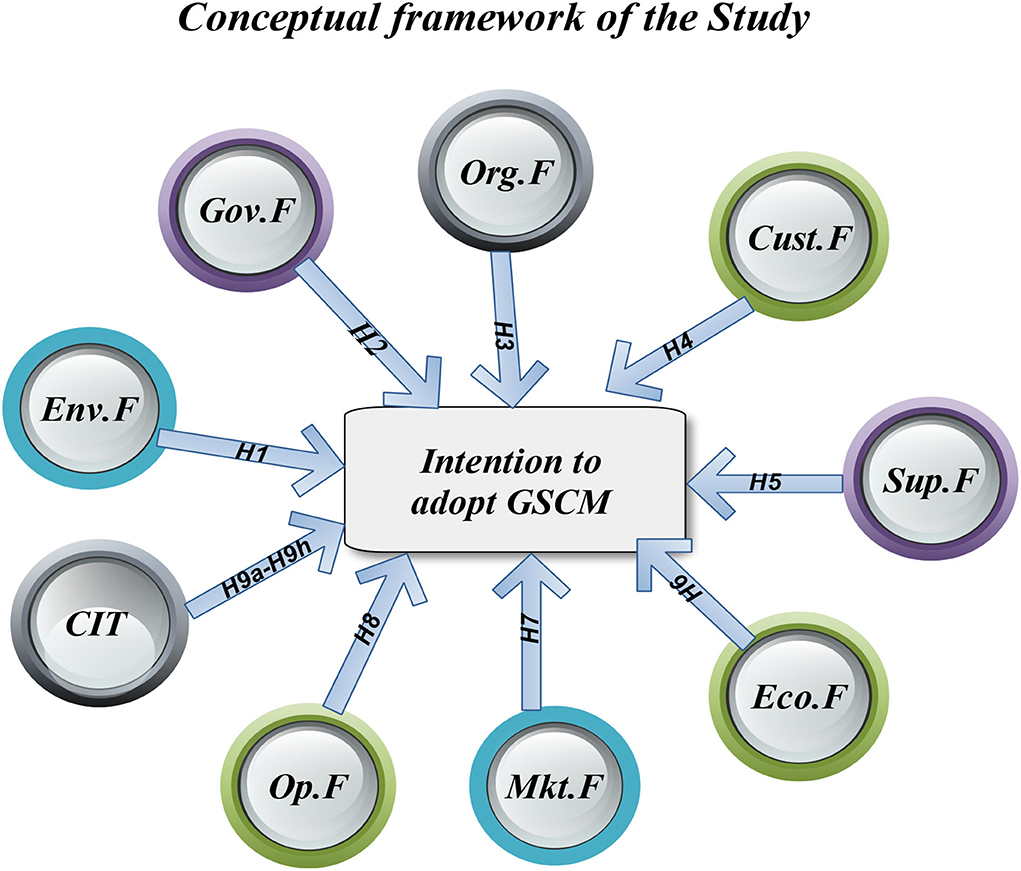
Figure 1. The conceptual framework of the study's hypotheses development. Env.F, Environmental Factor (H1) → Intention to adopt GSCM; Gov.F, Governmental Factor (H2) → Intention to adopt GSCM; Org.F, Organization Factor (H3) → Intention to adopt GSCM; Cust.F, Customer Factor (H4) → Intention to adopt GSCM; Sup.F, Supplier Factor (H5) → Intention to adopt GSCM; Eco.F, Economic Factor (H6) → Intention to adopt GSCM; Mkt.F, Market Factor (H7) → Intention to adopt GSCM; Op.F, Operational Factor (H8) → Intention to adopt GSCM; CIT, CIT (H9a–H9h) → Intention to adopt GSCM.
Results and discussions
Table 4 provides the descriptive statistics of the study which includes the total number of observations (N), the value of the latent variable, mean statistics, standard deviation, as well as the value of “skewness and kurtosis. In this research, the value of skewness and kurtosis are used for the normalcy of the given data.
If the skewness value tilts to the left, it means a negative value. On the other hand, a tilt to the right indicates positive skewness. Kurtosis is a term used to describe data that has either peaksoris flat (Khorasani et al., 2014). As seen in Figure 2, the negative kurtosis value indicates the distribution is flatter than a normal curve with the same mean as well as standard deviation. Similarly, a positive kurtosis value indicates that the distribution is peaked and has a long tail. The values ranging from −3 and +3 show the skewness fall while the kurtosis ranges from −10 to +10. The results presented in Table 4 indicate that the environmental factor has the greatest mean value (Mean = 3.95), while the organizational factor has the lowest mean value (Mean = 3.03).
Table 5 lists the multicollinearity statistics and presents how the many independent variables correlate with each other in the model. The statistical analysis' path coefficients may change due to the significant correlations between the independent variables. In this study, the variance inflation factor (VIF) and tolerance levels were used to analyze and identify multicollinearity (Senaviratna and Cooray, 2019). The findings of the study indicate that the VIF values of environmental factors, government factors, organizational factors, customer factors, economic factors, market factors, and operational factors are less than 5 and tolerance values of all the factors are more than 0.10 as shown in Table 5. Hence, the results demonstrate that there is no multicollinearity in this study.
The results of the convergent validity and reliability are shown in Table 6. In this study, we utilized Cronbach's alpha (CR) and composite reliability to analyze and test the latent variables. The significant value of CR is more than 0.7 which indicated the latent variables are very dependable.
In this research, the results show that the CR values are greater than 0.70 in all latent variables, indicating that reliability has been established. The findings also show that convergent validity is determined by factor loading values greater than 0.70 as well as the average variance extracted (AVE), values, which were also greater than 0.50 in this study, suggesting that the research is appropriate.
Table 7 presents the results of the discriminant validity test. From Table 7, we find that the discriminant validity is achieved when the value of the square root (AVE) is greater and higher than the coefficients of correlation among all including constructs. The square root values of the environmental factor, governmental factor, organization factor, customer factor, supplier factor, economics factor, market factor, and operational factor are greater. These results indicate that all latent variables contain higher values as compared to the square root values. Hence the discriminating validity of the latent variables is established.
The results of the structural model analysis are presented in Table 8, including the p-values, t-statistics, and the path coefficients of the variables. According to the findings of the study, six out of eight factors have a substantial and favorable influence on adopting GSCM practices. The study's findings reveal that market and operational factors are highly significant to adopt GSCM practices at a p-value of 0.05. Environmental and organizational factors are also strongly significant for adopting GSCM practices with a p-value of 0.10. The overall finding of this study indicates that hypotheses H1, H2, H3, H5, H7, and H8 are positively significant for adopting GSCM practices for sustainable production and consumption as well as enterprise efficiency.
Table 9 shows the findings of the moderation analysis. Clean innovation technology as a mediator considerably moderates the impact of four variables and strongly influences the use of GSCM practices. It substantially mitigates the influence of governmental and economic variables on the desire to adopt GSCM at a p-value of 0.05. The results also indicate that CIT mitigates the influence of market factors on the intention to adopt GSCM at a p-value of 0.10. Hypotheses H9a, H9b, h9f, and H9g are all validated and support the use of CIT to boost the enterprise's production and consumption.
Figure 3 demonstrates that environmental, governmental, organizational, market, and operational factors significantly influence CEOs' intentions to adopt GSCM practices.
The environmental factor (Figure 3) includes five important items (E11–E15) such as recycling of construction materials, proper waste reduction, carbon emission reduction as well as sustainable construction materials. The highest factor loading value of 0.84 indicates the highest intention to adopt GSCM practices. The governmental factor contains seven items (G11–G17), including initial government financial support, technical support from the government, innovative training from the government, the anticipation of government legislation, rules and regulations, and new innovative policies from the government to adopt GSCM practices. The highest factor loading of the government factor value of 0.86 indicates the highest intention to adopt GSCM practices for sustainable production and consumption. The organizational factor has three items (O11–O13), including increasing employees, increasing labor productivity, and providing support to all workers for CEOs to adopt GSCM practices. The highest factor loading of the organization factor value of 0.83 indicates the highest intention to adopt GSCM practices. The suppliers' factor includes four items (S11–S14) of the firms' environmental association with suppliers, the firm's awareness and friendly environment with suppliers, the firm's environmental collaboration, and product designer collaboration. The highest factor loading of supplier factor value of 0.87 indicates the highest intention to adopt GSCM practices. The market factor includes the four items (M11–M14), containing the ability to increase the values of property, to provide tax incentives, like establishing a firm's green image, and to decrease infrastructure strain by adopting GSCM practices. The operational factor has three items (Op11–Op13) such as increasing the product services and design, decreasing the cost of operation, and the enterprise providing new equipment and technology. It had a factor loading value of 0.93 to adopt GSCM practices. In this research, the moderating effect of CIT was significant in the relationships between CIT and environmental factors, economic factors, governmental factors, and market factors. The overall finding of the study indicated that the adoption of GSCM practices and CIT are beneficial for enterprises' performances.
Conclusion and policy implications
The purpose of this research was to determine the factors that influence GSCM adoption in Pakistan SMEs and the moderating effect of CIT for sustainable production and consumption. As a result, the research has made significant contributions. For example, the study provides academics and decision-makers with a comprehensive framework that identifies the factors that impact decisions regarding GSCM practices. According to the data, the most significant drivers of GSCM adoption among CEOs are environmental, governmental, organizational, supplier, market, and operational factors. The most important variables are those that are connected to CEOs' intentions to adopt GSCM. The most influential elements are identified in this research, with the organizational component having a major impact, followed by the environmental factor, the governmental factor, the supplier factor, the market factor, and the operational factor.
In this research, the results show that the CR values are greater than 0.70 in all latent variables, indicating that reliability has been established. The findings also show that convergent validity is determined by factor loading values of more than 0.70 as well as average variance extracted (AVE) values greater than 0.50. The AVE was more than 0.50, and all factor loading values were greater than 0.70, suggesting that the research is accurate. We find that the discriminant validity is achieved when the value of the square root (AVE) is greater and higher than the coefficients of correlation among all including constructs. The square root values of the environmental factor, governmental factor, organization factor, customer factor, supplier factor, economics factor, market factor, and operational factor are greater. The results of the study indicate that all latent variables contained higher values as compared to the square root values. Hence the discriminating validity of the latent variables is established.
The overall finding of the study will help the policymakers when they intend to apply GSCM practices and CIT. The findings confirm that CIT positively and significantly moderates the relationship between CIT and other factors such as governmental factors, economic factors, and market factors for sustainable production and consumption. In other words, small manufacturing enterprises are more likely to adopt GSCM practices as compared to large manufacturing enterprises.
The findings from this research also establish that the organizational factor is the most important factor influencing the adoption of GSCM. It can promote the adoption of GSCM and CIT by improving corporate social responsibility and labor productivity. The government plays an equally important role. The government should increase the support for SMEs by providing requisite finance and technology, and formulating relevant policies and regulations to ensure the green transformation of enterprises. In addition, improving social environmental awareness, creating a good business environment and enterprise cooperation, increasing product services and design, reducing operating costs, and establishing an enterprise green brand image can effectively contribute to the green transformation of enterprises.
Discussions
This study evaluated the critical success factors influencing the adoption of GSCM and CIT in the manufacturing SMEs of Pakistan. The results of the study revealed that six factors, namely, environmental, government, organization, suppliers, market, and operational factors significantly influence the intention to adopt GSCM and positively impact sustainable production. The result of the structural model analysis included the p-values, t-statistics, and the path coefficients of the variables. It revealed that market and operational factors are highly significant to adopt GSCM practices with a p-value of 0.05. Environmental and organizational factors are also strongly significant in influencing decisions regarding GSCM practices with a p-value of 0.10. The overall finding of the study indicates that hypotheses H1, H2, H3, H5, H7, and H8 are positively significant to adopt GSCM practices for sustainable production and consumption as well as enterprise efficiency. The study also found that CIT as a mediator considerably moderates the impact of four variables and strongly influences the use of GSCM. Clean innovation technology substantially mitigates the influence of governmental and economic variables on the desire to adopt GSCM with a p-value of 0.05. The results also indicate that CIT mitigates the influence of market factors on the intention to adopt GSCM with a p-value of 0.10. The adoption of GSCM and CIT has gained contemporary research significance in the context of Pakistan SMEs, and this study would be of interest to academics as well as stakeholders, including policymakers, invested in sustainable production and consumption, and environmental improvement.
Limitations and future research
There are several limitations to this study. This empirical research addresses only eight factors that may impact decisions to adopt GSCM practices, and future studies should consider other parameters. Also, this research only looked at CIT as a mediator; future studies could consider including other social demographic characteristics as moderators, which might generate new and different results.
Data availability statement
The original contributions presented in the study are included in the article/supplementary material, further inquiries can be directed to the corresponding author.
Ethics statement
Ethical review and approval was not required for the study on human participants in accordance with the local legislation and institutional requirements. Written informed consent from the (patients/participants or patients/participants legal guardian/next of kin) was not required to participate in this study in accordance with the national legislation and the institutional requirements.
Author contributions
SM reviewed the literature, proposed the research model, and designed the study. YZ conducted the literature search, proceeded with the data extraction process, was involved in the development of the manuscript, put forward many constructive suggestions for revising the manuscript, and supervised the entire writing process. SM and IJ conducted the statistical analysis and revised the manuscript critically for important content. YZ, XL, and SH revised the whole manuscript according to the comments of the reviewer and rechecked the relevant data of the manuscript. IJ and KS participated in the writing of the first manuscript. All authors have equal contributions and approve the final manuscript to be published.
Funding
Financial support was given by the National Science Foundation of China (Grant No. 71901129).
Acknowledgments
This study is part of a Ph.D. research at the School of Business, Qingdao University, China. SM acknowledges the support provided by YZ (School of Business, Qingdao University, China) for this research work.
Conflict of interest
The authors declare that the research was conducted in the absence of any commercial or financial relationships that could be construed as a potential conflict of interest.
Publisher's note
All claims expressed in this article are solely those of the authors and do not necessarily represent those of their affiliated organizations, or those of the publisher, the editors and the reviewers. Any product that may be evaluated in this article, or claim that may be made by its manufacturer, is not guaranteed or endorsed by the publisher.
References
Abdeljawed, H. B., and Amraoui, L. E. (2021). Prospects for synergies between low-voltage DC microgrid technology and peer-to-peer energy trading markets. Sustain. Prod. Consum. 28, 1286–1296. doi: 10.1016/j.spc.2021.07.029
Al Khattab, S. A., and As'ad, H. (2015). The impact of the green supply chain management on environmental-based marketing performance. J. Serv. Sci. Manag. 8, 588. doi: 10.4236/jssm.2015.84059
Alavi, B., Tavana, M., and Mina, H. (2021). A dynamic decision support system for sustainable supplier selection in circular economy. Sustain. Produc. Consum. 27, 905–920. doi: 10.1016/j.spc.2021.02.015
Al-Ghwayeen, W. S., and Abdallah, A. B. (2018). Green supply chain management and export performance: the mediating role of environmental performance. J. Manuf. Technol. Manag. 29, 1233–1252. doi: 10.1108/JMTM-03-2018-0079
Al-Swidi, A. K., Gelaidan, H. M., and Saleh, R. M. (2021). The joint impact of green human resource management, leadership and organizational culture on employees' green behaviour and organisational environmental performance. J. Clean. Produc. 316, 128112. doi: 10.1016/j.jclepro.2021.128112
Bag, S., Gupta, S., Kumar, S., and Sivarajah, U. (2021). Role of technological dimensions of green supply chain management practices on firm performance. J. Enterp. Inf. Manag. 34, 1–27. doi: 10.1108/JEIM-10-2019-0324
Banik, A., Taqi, H., Ali, S., Ahmed, S., Garshasbi, M., and Kabir, G. (2022). Critical success factors for implementing green supply chain management in the electronics industry: an emerging economy case. Int. J. Logist. Res. Appl. 25, 493–520. doi: 10.1080/13675567.2020.1839029
Bowen, J. T., and Chen, S. L. (2001). The relationship between customer loyalty and customer satisfaction. Int. J. Contemp. Hosp. Manag. 13, 213–217. doi: 10.1108/09596110110395893
Chen, C. C., Shih, H. S., Shyur, H. J., and Wu, K. S. (2012). A business strategy selection of green supply chain management via an analytic network process. Comput. Math. Appl. 64, 2544–2557. doi: 10.1016/j.camwa.2012.06.013
Darwish, S., Shah, S., and Ahmed, U. (2021). The role of green supply chain management practices on environmental performance in the hydrocarbon industry of Bahrain: testing the moderation of green innovation. Uncert. Supply Chain Manag. 9, 265–276. doi: 10.5267/j.uscm.2021.3.006
Deng, Y., You, D., and Wang, J. (2022). Research on the nonlinear mechanism underlying the effect of tax competition on green technology innovation-An analysis based on the dynamic spatial Durbin model and the threshold panel model. Resour Policy. (2022) 76:102545. doi: 10.1016/j.resourpol.2021.102545
El Baz, J., and Iddik, S. (2022). Green supply chain management and organizational culture: a bibliometric analysis based on Scopus data (2001–2020). Int. J. Organ. Anal. 30, 156–179. doi: 10.1108/IJOA-07-2020-2307
Feng, M. Y., Yu, W. T., Wang, X. Y., Wong, C. Y., Xu, M. Z., and Xiao, Z. (2018). Green supply chain management and financial performance: the mediating roles of operational and environmental performance. Bus. Strateg. Environ. 27, 811–824. doi: 10.1002/bse.2033
Feng, T. W., Jiang, Y. S., and Xu, D. H. (2020). The dual-process between green supplier collaboration and firm performance: a behavioralperspective. J. Clean. Produc. 260, 121073. doi: 10.1016/j.jclepro.2020.121073
Jum'a, L., Ikram, M., Alkalha, Z., and Alaraj, M. (2021). Factors affecting managers' intention to adopt green supply chain management practices: evidence from manufacturing firms in Jordan. Environ. Sci. Pollut. 29, 605–5621. doi: 10.1007/s11356-021-16022-7
Kalyar, M.N., Shoukat, A., and Shafique, I. (2020). Enhancing firms' environmental performance and financial performance through green supply chain management practices and institutional pressures. Sustain. Account. Manag. 11, 451–476. doi: 10.1108/SAMPJ-02-2019-00
Khan, S. A. R., Chen, J., Zhang, Y., and Golpîra, H. (2019). Effect of green purchasing, green logistics, and ecological design on organizational performance: a path analysis using structural equation modeling. Inf. Technol. Intel. Transp. Syst. 314, 183–190. doi: 10.3233/978-1-61499-939-3-183
Khorasani, A. M., Littlefair, G., and Goldberg, M. (2014). Time domain vibration signal processing on milling process for chatter detection. J. Mach. Form. Technol. 6, 45.
Kuo, T. C., Hong, I. H., and Lin, S. C. (2016). Do carbon taxes work? Analysis of government policies and enterprise strategies in equilibrium. J. Clean. Produc. 139, 337–346. doi: 10.1016/j.jclepro.2016.07.164
Laari, S., Töyli, J., and Ojala, L. (2017). Supply chain perspective on competitive strategies and green supply chain management strategies. J. Clean. Produc. 141, 1303–1315. doi: 10.1016/j.jclepro.2016.09.114
Lee, S., Kim, B. S., Kim, Y., Kim, W., and Ahn, W. (2018). The framework for factors affecting technology transfer for suppliers and buyers of technology in Korea. Technol. Anal. Strateg. 30,172–185. doi: 10.1080/09537325.2017.1297787
Li, G., Li, L., Choi, T. M., and Sethi, S. P. (2020). Green supply chain management in Chinese firms: innovative measures and the moderating role of quick response technology. J. Oper. Manage. 66, 958–988. doi: 10.1002/joom.1061
Lim, M. K., Lai, M., Wang, C., and Lee, S. Y. (2022). Circular economy to ensure production operational sustainability: a green-lean approach. Sustain. Produc. Consump. 30, 130–144. doi: 10.1016/j.spc.2021.12.001
Liu, D., Yu, X., Huang, M., Yang, S., Isa, S. M., and Hu, M. (2022). The effects of green intellectual capital on green innovation: a green supply chain integration perspective. Front. Psychol. 13, 830716–830716. doi: 10.3389/fpsyg.2022.830716
Liu, J., Yuan, C., Hafeez, M., and Yuan, Q. (2018). The relationship between environment and logistics performance: evidence from Asian countries. J. Clean. Produc. 204, 282–291. doi: 10.1016/j.jclepro.2018.08.310
Liu, L., Wang, Z., and Zhang, Z. S. Matching-game approach for green technology investment strategies in a supply chain under environmental regulations. Sustain Prod Consum. (2021) 28:371–90. doi: 10.1016/j.spc.2021.06.001
Liu, S., Eweje, G., He, Q., and Lin, Z. (2020). Turning motivation into action: a strategic orientation model for green supply chain management. Bus. Strateg. Environ. 29, 2908–2918. doi: 10.1002/bse.2580
Lu, Q., Song, L., and Yu, K. (2022). The effects of operational and digitalization capabilities on SMSs' supply chain financing under supply risk. Int. J. Logist. Res. Appl. doi: 10.1080/13675567.2022.2104232
Luthra, S., Garg, D., and Haleem, A. (2015). An analysis of interactions among critical success factors to implement green supply chain management towards sustainability: an Indian perspective. Resourc. Policy. 46, 37–50. doi: 10.1016/j.resourpol.2014.12.006
Lv, H. J., and Li, D. D. (2021). Impacts of heterogeneous green consumers on green innovation in electric vehicle and charging pile firms. Sustain. Produc. Consum. 28, 1216–1231. doi: 10.1016/j.spc.2021.08.002
Meng, Q. F., Li, M. W., Liu, W. Y., Li, Z., and Zhang, J. (2021). Pricing policies of dual-channel green supply chain: considering government subsidies and consumers' dual preferences. Sustain. Produc. Consum. 26, 1021–1030. doi: 10.1016/j.spc.2021.01.012
Mitchell, R. J. (1992). Testing evolutionary and ecological hypotheses using path analysis and structural equation modelling. Funct. Ecol. 6, 123–129. doi: 10.2307/2389745
Mitra, S., and Datta, P. P. (2014). Adoption of green supply chain management practices and their impact on performance: an exploratory study of Indian manufacturing firms. J. Product. Rese. 52, 2085–2107. doi: 10.1080/00207543.2013.849014
Mondal, C., and Giri, B. C. (2022). Investigating strategies of a green closed-loop supply chain for substitutable products under government subsidy. J. Ind. Prod. Eng. 39, 253–276. doi: 10.1080/21681015.2021.1974962
Mumtaz, U., Ali, Y., Petrillo, A., and Felice, F. D. (2018). Identifying the critical factors of green supply chain management: environmental benefits in Pakistan. Sci. Total. Environ. 1, 640–641. doi: 10.1016/j.scitotenv.2018.05.231
Nayak, R. (2020). “Sustainable supply chain management: challenges from a fashion perspective,” in Supply Chain Management and Logistics in the Global Fashion Sector: The Sustainability Challenge (Londong: Routledge), pp. 3–32. doi: 10.4324/9781003089063-2
Nguyen, T. T. H., Pham, T. L., Phan, T., Than, T. T. H., Than, T. T., and Nguyen, T. Q. A. (2020). Impact of green supply chain practices on financial and non-financial performance of Vietnam's tourism enterprises. Uncert. Supply Chain Manag. 8, 81–494. doi: 10.5267/j.uscm.2020.4.004
Petrudi, S. H. H., Ahmadi, H. B., Rehman, A., and Liou, J. J. H. (2021). Assessing suppliers considering social sustainability innovation factors during COVID-19 disaster. Sustain. Prod. Consum. 27, 1869–1881. doi: 10.1016/j.spc.2021.04.026
Pourjavad, E., and Shahin, A. (2020). A hybrid model for analyzing the risks of green supply chain in a fuzzy environment. J. Ind. Prod. Eng. 37, 422–433. doi: 10.1080/21681015.2020.1833995
Rupa, R. A., and Saif, A. N. M. (2022). Impact of green supply chain management (GSCM) on business performance and environmental sustainability: case of a developing country. Bus. Perspect. Res. 10, 140–163. doi: 10.1177/2278533720983089
Selviaridis, K., and Spring, M. (2022). Fostering SME supplier-enabled innovation in the supply chain: the role of innovation policy. J. Supply Chain Manag. 58, 92–123. doi: 10.1111/jscm.12274
Seman, N. A. A., Govindan, K., Mardani, A., Zakuan, N., Saman, M. Z. M., Hooker, R. E., et al. (2019). The mediating effect of green innovation on the relationship between green supply chain management and environmental performance. J. Clean. Prod. 229, 115–127. doi: 10.1016/j.jclepro.2019.03.211
Senaviratna, N. A. M. R., and Cooray, T. M. J. A. (2019). Diagnosing multicollinearity of logistic regression model. Asian J. Prob. Statist. 5, 1–9. doi: 10.9734/ajpas/2019/v5i230132
Sharma, V. K., Chandna, P., and Bhardwaj, A. (2017). Green supply chain management related performance indicators in agro industry: a review. J. Clean. Prod. 141, 1194–1208. doi: 10.1016/j.jclepro.2016.09.103
Shekarian, E., Ijadi, B., Zare, A., and Majava, J. (2022). Sustainable supply chain management: a comprehensive systematic review of industrial practices. Sustainability 14, 7892. doi: 10.3390/su14137892
Shen, C. Y., and Yu, K. T. (2009). Enhancing the efficacy of supplier selection decision-making on the initial stage of new product development: a hybrid fuzzy approach considering the strategic and operational factors simultaneously. Expert. Syst. Appl. 36, 11271–11281. doi: 10.1016/j.eswa.2009.02.083
Sun, H. X., and Li, J. L. (2021). Behavioural choice of governments, enterprises and consumers on recyclable green logistics packaging. Sustain. Prod. Consum. 28, 459–471. doi: 10.1016/j.spc.2021.06.011
Tachizawa, E. M., and Wong, C. Y. (2015). The performance of green supply chain management governance mechanisms: asupply network and complexity perspective. J. Supply Chain Manag. 51, 18–32. doi: 10.1111/jscm.12072
Tian, Y. H., Govindan, K., and Zhu, Q. H. (2014). A system dynamics model based on evolutionary game theory for green supply chain management diffusion among Chinese manufacturers. J. Clean. Prod. 80, 96–105. doi: 10.1016/j.jclepro.2014.05.076
Valor, C., Ronda, L., and Abril, C. (2022). Understanding the expansion of circular markets: building relational legitimacy to overcome the stigma of second-hand clothing. Sustain. Prod. Consum. 30, 77–88. doi: 10.1016/j.spc.2021.11.027
Wang, H., Khan, M. A. S., Anwar, F., Shahzad, F., Adu, D., and Murad, M. (2021). Green innovation practices and its impacts on environmental and organizational performance. Front. Psychol. 11, 553625. doi: 10.3389/fpsyg.2020.553625
Wang, M., and Feng, C. (2019). Impacts of oriented technologies and economic factors on China's industrial climate mitigation. J. Clean. Prod. 233, 1016–1028. doi: 10.1016/j.jclepro.2019.06.134
Yavari, M., and Ajalli, P. (2021). Suppliers' coalition strategy for green-Resilient supply chain network design. J. Ind. Prod. Eng. 38, 197–212. doi: 10.1080/21681015.2021.1883134
Younis, H., and Sundarakani, B. (2020). The impact of firm size, firm age and environmental management certification on the relationship between green supply chain practices and corporate performance. Benchmark. Int. J. 27, 319–346. doi: 10.1108/BIJ-11-2018-0363
Zaid, A. A., Jaaron, A. A., and Bon, A. T. (2018). The impact of green human resource management and green supply chain management practices on sustainable performance: an empirical study. J. Clean. Prod. 204, 965–979. doi: 10.1016/j.jclepro.2018.09.062
Zastempowski, M., and Cyfert, S. (2021). Social responsibility of SMEs from the perspective of their innovativeness: evidence from Poland. J. Clean. Prod. 317, 128400. doi: 10.1016/j.jclepro.2021.128400
Zhang, H., Shao, Y., Han, X, and Chang, H. (2022). A road towards ecological development in China: The nexus between green investment, natural resources, green technology innovation, and economic growth. Resourc. Policy 77,102746. doi: 10.1016/j.resourpol.2022.102746
Zhang, N., and Zhao, Y. (2022). Green supply chain management in the platform economy: a bibliometric analysis. Int. J. Logist. Res. Appl. 25, 639–655. doi: 10.1080/13675567.2021.1885635
Zhang, W., Zhang, X., and Zhou, Q. (2021). How does knowledge seeking and knowledge generation promote green supply chain management? An empirical study from China. Int. J. Logist. Res. Appl. doi: 10.1080/13675567.2021.1929882
Zhang, Y. L., Sun, J., Yang, Z. J., and Wang, Y. (2020). Critical success factors of green innovation: technology, organization and environment readiness. J. Clean. Prod. 264, 121701. doi: 10.1016/j.jclepro.2020.121701
Zhou, M., Govindan, K., Xie, X., and Yan, L. (2021). How to drive green innovation in China's mining enterprises? Under the perspective of environmental legitimacy and green absorptive capacity. Resourc. Policy. 72, 102038. doi: 10.1016/j.resourpol.2021.102038
Keywords: green supply chain management (GSCM), clean innovation technology (CIT), sustainable production, small and medium-sized enterprise (SME), adaptation, structural equation modeling (SEM)
Citation: Maqsood S, Zhou Y, Lin X, Huang S, Jamil I and Shahzad K (2022) Critical success factors for adopting green supply chain management and clean innovation technology in the small and medium-sized enterprises: A structural equation modeling approach. Front. Psychol. 13:1008982. doi: 10.3389/fpsyg.2022.1008982
Received: 01 August 2022; Accepted: 26 September 2022;
Published: 03 November 2022.
Edited by:
Chien-liang Lin, Ningbo University, ChinaReviewed by:
Ming Lang Tseng, Asia University, TaiwanRiaqa Mubeen, Harbin Institute of Technology, China
Copyright © 2022 Maqsood, Zhou, Lin, Huang, Jamil and Shahzad. This is an open-access article distributed under the terms of the Creative Commons Attribution License (CC BY). The use, distribution or reproduction in other forums is permitted, provided the original author(s) and the copyright owner(s) are credited and that the original publication in this journal is cited, in accordance with accepted academic practice. No use, distribution or reproduction is permitted which does not comply with these terms.
*Correspondence: Yan Zhou, eWFuemhvdSYjeDAwMDQwO3FkdS5lZHUuY24=
 Shoaib Maqsood
Shoaib Maqsood Yan Zhou
Yan Zhou Xintong Lin
Xintong Lin Shuai Huang
Shuai Huang Ihsan Jamil
Ihsan Jamil Khurram Shahzad
Khurram Shahzad